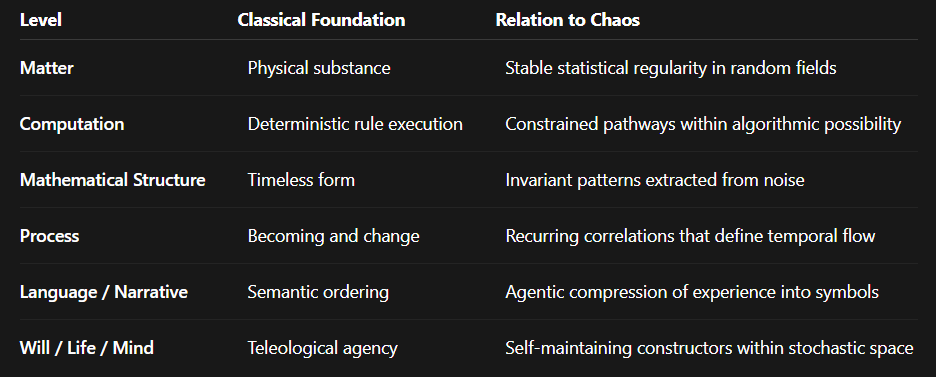Chaos as Foundation
Maximal entropy, minimal description, zero meaning
Metaphysics has always sought the ultimate ground. Travers catalogued a dozen candidates—matter, language, computation, mathematical structure, process, God—each claiming to underwrite the rest. Yet every such claim is itself a pattern: a coherence carved from something deeper. Our Chaos theory posits that what lies beneath them all is not a substance or a law, but measureless randomness itself.
1. The Ontic Substrate
Chaos, in this sense, is not disorder. It is the total ensemble of possibility—the continuum of information containing both incompressible and computable sequences. Everything lawful, meaningful, or structured is a low-measure subset within it. Physics, mathematics, and consciousness are coherences that persist because they are locally compressible; they reduce entropy by drawing boundaries in the sea of unbounded variation.
2. Emergent Foundations
Where Travers and the classical metaphysicians saw rival first principles, we see emergent layers:
Each is an island of order—a region of Chaos that sustains itself through internal coherence.
3. Why Chaos Is the Simplest
Chaos requires no axioms, no entities, and no secondary ontology. It is the default condition of possibility for any law or structure. All other foundations posit rules, substances, or constraints; Chaos posits only the absence of them. To define anything, one must already presuppose a domain of definable distinctions. Chaos is that domain—the unbounded space of all possible distinctions.
Mathematical structure assumes the consistency of logic; computation presumes valid transitions; process presupposes temporal correlation. Chaos presupposes nothing. It is the prior state of all priors—the limit condition where every possible law has measure zero yet remains contained.
4. The Information Content of Chaos
From an informational standpoint, Chaos exhibits a threefold paradox:
Shannon information – At the probabilistic level, Chaos has maximal entropy. Every bit is independent and unpredictable; uncertainty per symbol is maximal. In this sense, Chaos is the most information-dense medium possible.
Algorithmic information – Each individual random sequence within Chaos has maximal Kolmogorov complexity—it cannot be compressed. Yet the ensemble of all possible sequences is defined by a minimal rule: the set of all bitstrings. Chaos, as a totality, has minimal description length.
Semantic information – Chaos contains no meaning until coherence emerges. Information, in the semantic sense, requires recognition and compression by an agent. Randomness alone communicates nothing.
Thus, Chaos is simultaneously:
Chaos is a field of maximal uncertainty, trivially definable as a whole, and devoid of intrinsic meaning—until coherence arises.
5. The Philosophical Consequence
Chaos is not a rival to the other foundations—it is their condition. To ask what lies beneath it is to ask for a rule prior to rulemaking. There is none. Chaos, defined as the total ensemble of all possible sequences—both random and computable—is the most inclusive and minimally specifiable foundation conceivable. It is both the ground and the horizon of intelligibility.
Within Chaos, order emerges through coherence and selection. From incompressibility, coherence. From measureless possibility, the limited worlds where meaning, mind, and mathematics take root.




